University Finance Report: Financial Resource Management and Decisions
VerifiedAdded on 2019/12/03
|23
|6157
|373
Report
AI Summary
This report comprehensively addresses financial resource management and decision-making within an organization. It begins by outlining the types of finance sources available, differentiating between internal and external options, and assessing the implications of each source, supported by case study examples. The report then delves into the costs associated with raising funds and emphasizes the importance of financial planning, including the types of financial information necessary for informed decision-making. It also includes an analysis of financial statements. The report further explores investment appraisal techniques such as payback period, accounting rate of return, net present value (NPV), and internal rate of return (IRR), while also examining contribution, profit, breakeven point, and margin of safety. Additionally, the report highlights the purpose and use of various financial statements, comparing statements across different organization types and concluding with an analysis of financial statements and their implications. The report uses tables to illustrate calculations and analysis.

MANAGING FINANCIAL
RESOURCES AND
DECISIONS
1 | P a g e
RESOURCES AND
DECISIONS
1 | P a g e
Paraphrase This Document
Need a fresh take? Get an instant paraphrase of this document with our AI Paraphraser

TABLE OF CONTENTS
INTRODUCTION......................................................................................................................1
TASK 1......................................................................................................................................1
AC 1.1 Types of finance sources...........................................................................................1
AC 1.2 Implication of each finance sources..........................................................................1
AC 1.3 Case study examples.................................................................................................2
TASK 2......................................................................................................................................2
AC 2.1 cost of finance sources to raise the funds..................................................................2
AC 2.2 Importance of financial planning..............................................................................3
AC 2.3 Types of financial information required for decision making purpose.....................4
AC 2.4 Financial statements of the organizations.................................................................4
TASK 3......................................................................................................................................5
AC 3.1 Analysis of sales budget and cash budget ................................................................5
AC 3.3 Investment appraisal techniques...............................................................................5
AC 3.2 Contribution, profit, breakeven point and margin of safety......................................6
TASK 4....................................................................................................................................11
AC 4.1 Purpose and use of different statements of the organization..................................11
AC 4.2 Financial statements of different types of organization..........................................12
AC 4.3 Analysis of financial statements.............................................................................13
CONCLUSION........................................................................................................................14
REFERENCES.........................................................................................................................14
2 | P a g e
INTRODUCTION......................................................................................................................1
TASK 1......................................................................................................................................1
AC 1.1 Types of finance sources...........................................................................................1
AC 1.2 Implication of each finance sources..........................................................................1
AC 1.3 Case study examples.................................................................................................2
TASK 2......................................................................................................................................2
AC 2.1 cost of finance sources to raise the funds..................................................................2
AC 2.2 Importance of financial planning..............................................................................3
AC 2.3 Types of financial information required for decision making purpose.....................4
AC 2.4 Financial statements of the organizations.................................................................4
TASK 3......................................................................................................................................5
AC 3.1 Analysis of sales budget and cash budget ................................................................5
AC 3.3 Investment appraisal techniques...............................................................................5
AC 3.2 Contribution, profit, breakeven point and margin of safety......................................6
TASK 4....................................................................................................................................11
AC 4.1 Purpose and use of different statements of the organization..................................11
AC 4.2 Financial statements of different types of organization..........................................12
AC 4.3 Analysis of financial statements.............................................................................13
CONCLUSION........................................................................................................................14
REFERENCES.........................................................................................................................14
2 | P a g e
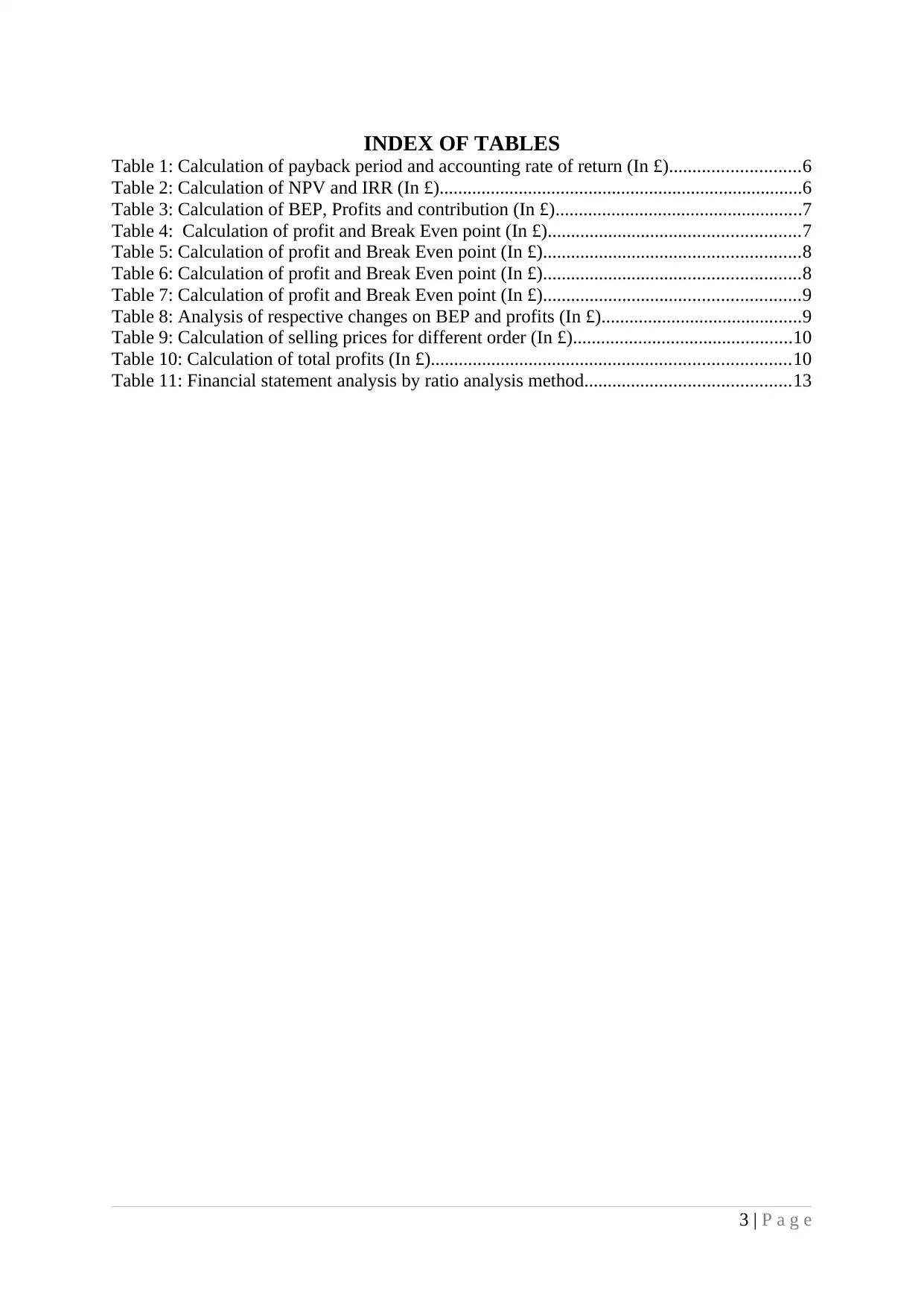
INDEX OF TABLES
Table 1: Calculation of payback period and accounting rate of return (In £)............................6
Table 2: Calculation of NPV and IRR (In £)..............................................................................6
Table 3: Calculation of BEP, Profits and contribution (In £).....................................................7
Table 4: Calculation of profit and Break Even point (In £)......................................................7
Table 5: Calculation of profit and Break Even point (In £).......................................................8
Table 6: Calculation of profit and Break Even point (In £).......................................................8
Table 7: Calculation of profit and Break Even point (In £).......................................................9
Table 8: Analysis of respective changes on BEP and profits (In £)...........................................9
Table 9: Calculation of selling prices for different order (In £)...............................................10
Table 10: Calculation of total profits (In £).............................................................................10
Table 11: Financial statement analysis by ratio analysis method............................................13
3 | P a g e
Table 1: Calculation of payback period and accounting rate of return (In £)............................6
Table 2: Calculation of NPV and IRR (In £)..............................................................................6
Table 3: Calculation of BEP, Profits and contribution (In £).....................................................7
Table 4: Calculation of profit and Break Even point (In £)......................................................7
Table 5: Calculation of profit and Break Even point (In £).......................................................8
Table 6: Calculation of profit and Break Even point (In £).......................................................8
Table 7: Calculation of profit and Break Even point (In £).......................................................9
Table 8: Analysis of respective changes on BEP and profits (In £)...........................................9
Table 9: Calculation of selling prices for different order (In £)...............................................10
Table 10: Calculation of total profits (In £).............................................................................10
Table 11: Financial statement analysis by ratio analysis method............................................13
3 | P a g e
⊘ This is a preview!⊘
Do you want full access?
Subscribe today to unlock all pages.

Trusted by 1+ million students worldwide
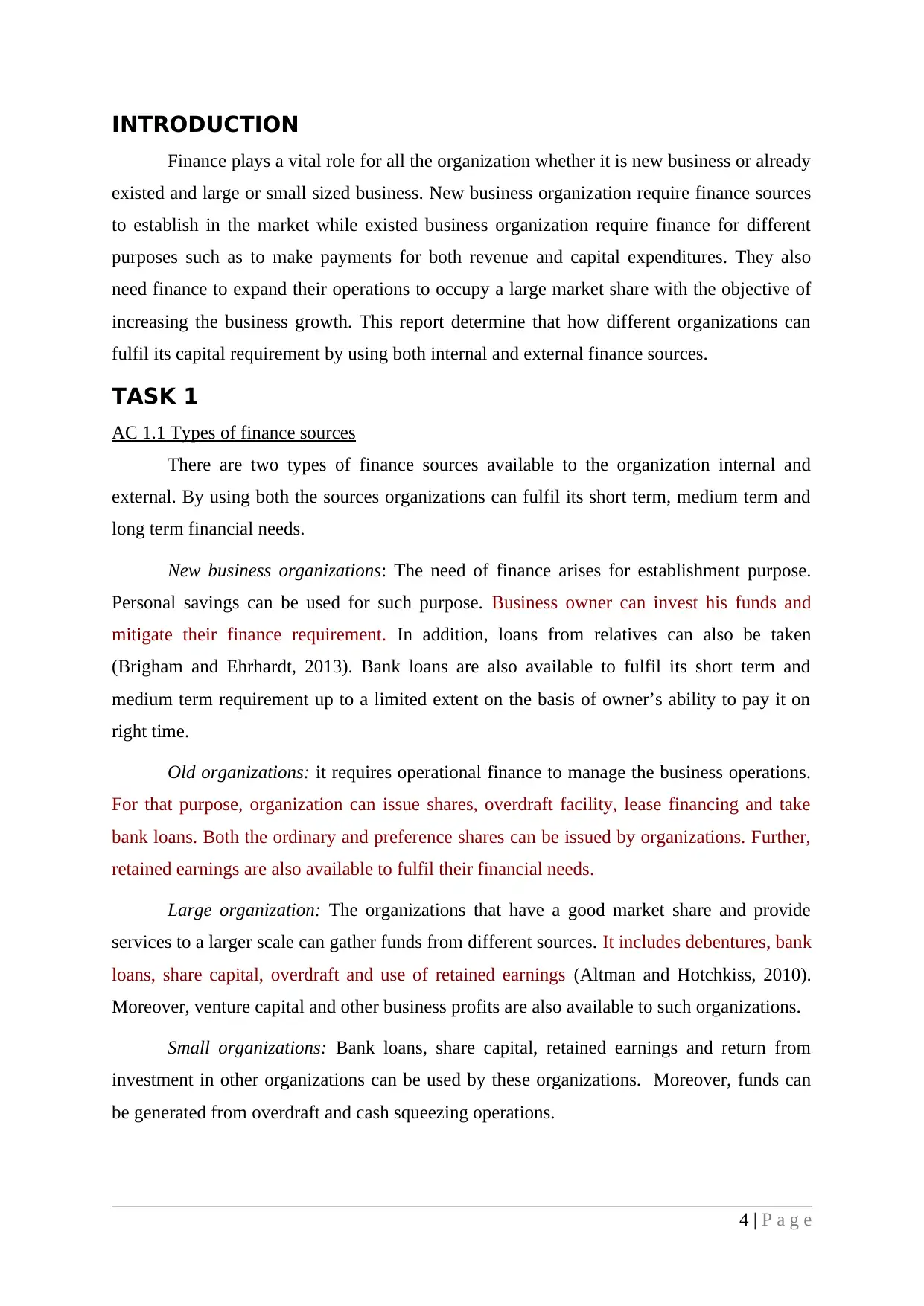
INTRODUCTION
Finance plays a vital role for all the organization whether it is new business or already
existed and large or small sized business. New business organization require finance sources
to establish in the market while existed business organization require finance for different
purposes such as to make payments for both revenue and capital expenditures. They also
need finance to expand their operations to occupy a large market share with the objective of
increasing the business growth. This report determine that how different organizations can
fulfil its capital requirement by using both internal and external finance sources.
TASK 1
AC 1.1 Types of finance sources
There are two types of finance sources available to the organization internal and
external. By using both the sources organizations can fulfil its short term, medium term and
long term financial needs.
New business organizations: The need of finance arises for establishment purpose.
Personal savings can be used for such purpose. Business owner can invest his funds and
mitigate their finance requirement. In addition, loans from relatives can also be taken
(Brigham and Ehrhardt, 2013). Bank loans are also available to fulfil its short term and
medium term requirement up to a limited extent on the basis of owner’s ability to pay it on
right time.
Old organizations: it requires operational finance to manage the business operations.
For that purpose, organization can issue shares, overdraft facility, lease financing and take
bank loans. Both the ordinary and preference shares can be issued by organizations. Further,
retained earnings are also available to fulfil their financial needs.
Large organization: The organizations that have a good market share and provide
services to a larger scale can gather funds from different sources. It includes debentures, bank
loans, share capital, overdraft and use of retained earnings (Altman and Hotchkiss, 2010).
Moreover, venture capital and other business profits are also available to such organizations.
Small organizations: Bank loans, share capital, retained earnings and return from
investment in other organizations can be used by these organizations. Moreover, funds can
be generated from overdraft and cash squeezing operations.
4 | P a g e
Finance plays a vital role for all the organization whether it is new business or already
existed and large or small sized business. New business organization require finance sources
to establish in the market while existed business organization require finance for different
purposes such as to make payments for both revenue and capital expenditures. They also
need finance to expand their operations to occupy a large market share with the objective of
increasing the business growth. This report determine that how different organizations can
fulfil its capital requirement by using both internal and external finance sources.
TASK 1
AC 1.1 Types of finance sources
There are two types of finance sources available to the organization internal and
external. By using both the sources organizations can fulfil its short term, medium term and
long term financial needs.
New business organizations: The need of finance arises for establishment purpose.
Personal savings can be used for such purpose. Business owner can invest his funds and
mitigate their finance requirement. In addition, loans from relatives can also be taken
(Brigham and Ehrhardt, 2013). Bank loans are also available to fulfil its short term and
medium term requirement up to a limited extent on the basis of owner’s ability to pay it on
right time.
Old organizations: it requires operational finance to manage the business operations.
For that purpose, organization can issue shares, overdraft facility, lease financing and take
bank loans. Both the ordinary and preference shares can be issued by organizations. Further,
retained earnings are also available to fulfil their financial needs.
Large organization: The organizations that have a good market share and provide
services to a larger scale can gather funds from different sources. It includes debentures, bank
loans, share capital, overdraft and use of retained earnings (Altman and Hotchkiss, 2010).
Moreover, venture capital and other business profits are also available to such organizations.
Small organizations: Bank loans, share capital, retained earnings and return from
investment in other organizations can be used by these organizations. Moreover, funds can
be generated from overdraft and cash squeezing operations.
4 | P a g e
Paraphrase This Document
Need a fresh take? Get an instant paraphrase of this document with our AI Paraphraser
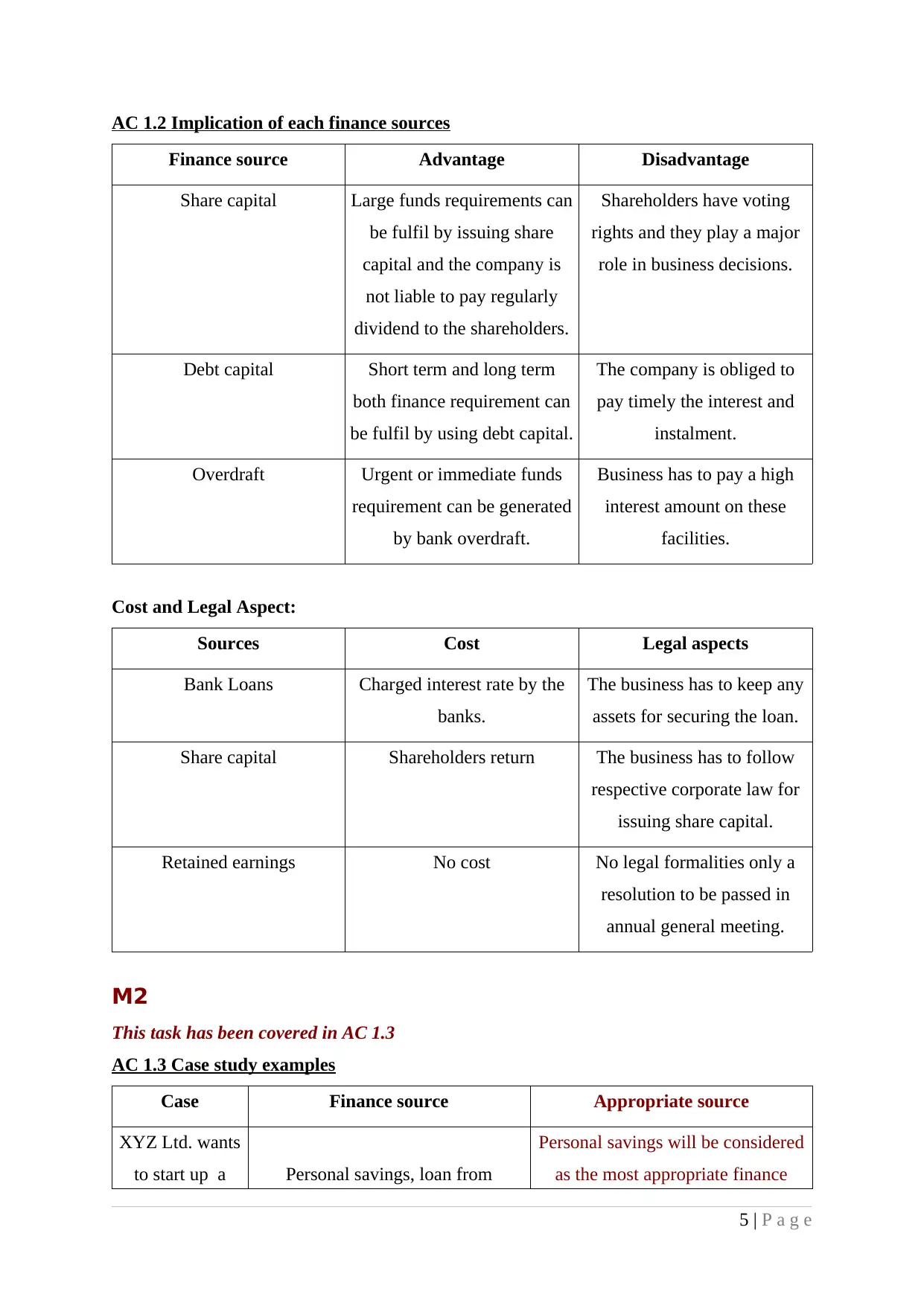
AC 1.2 Implication of each finance sources
Finance source Advantage Disadvantage
Share capital Large funds requirements can
be fulfil by issuing share
capital and the company is
not liable to pay regularly
dividend to the shareholders.
Shareholders have voting
rights and they play a major
role in business decisions.
Debt capital Short term and long term
both finance requirement can
be fulfil by using debt capital.
The company is obliged to
pay timely the interest and
instalment.
Overdraft Urgent or immediate funds
requirement can be generated
by bank overdraft.
Business has to pay a high
interest amount on these
facilities.
Cost and Legal Aspect:
Sources Cost Legal aspects
Bank Loans Charged interest rate by the
banks.
The business has to keep any
assets for securing the loan.
Share capital Shareholders return The business has to follow
respective corporate law for
issuing share capital.
Retained earnings No cost No legal formalities only a
resolution to be passed in
annual general meeting.
M2
This task has been covered in AC 1.3
AC 1.3 Case study examples
Case Finance source Appropriate source
XYZ Ltd. wants
to start up a Personal savings, loan from
Personal savings will be considered
as the most appropriate finance
5 | P a g e
Finance source Advantage Disadvantage
Share capital Large funds requirements can
be fulfil by issuing share
capital and the company is
not liable to pay regularly
dividend to the shareholders.
Shareholders have voting
rights and they play a major
role in business decisions.
Debt capital Short term and long term
both finance requirement can
be fulfil by using debt capital.
The company is obliged to
pay timely the interest and
instalment.
Overdraft Urgent or immediate funds
requirement can be generated
by bank overdraft.
Business has to pay a high
interest amount on these
facilities.
Cost and Legal Aspect:
Sources Cost Legal aspects
Bank Loans Charged interest rate by the
banks.
The business has to keep any
assets for securing the loan.
Share capital Shareholders return The business has to follow
respective corporate law for
issuing share capital.
Retained earnings No cost No legal formalities only a
resolution to be passed in
annual general meeting.
M2
This task has been covered in AC 1.3
AC 1.3 Case study examples
Case Finance source Appropriate source
XYZ Ltd. wants
to start up a Personal savings, loan from
Personal savings will be considered
as the most appropriate finance
5 | P a g e
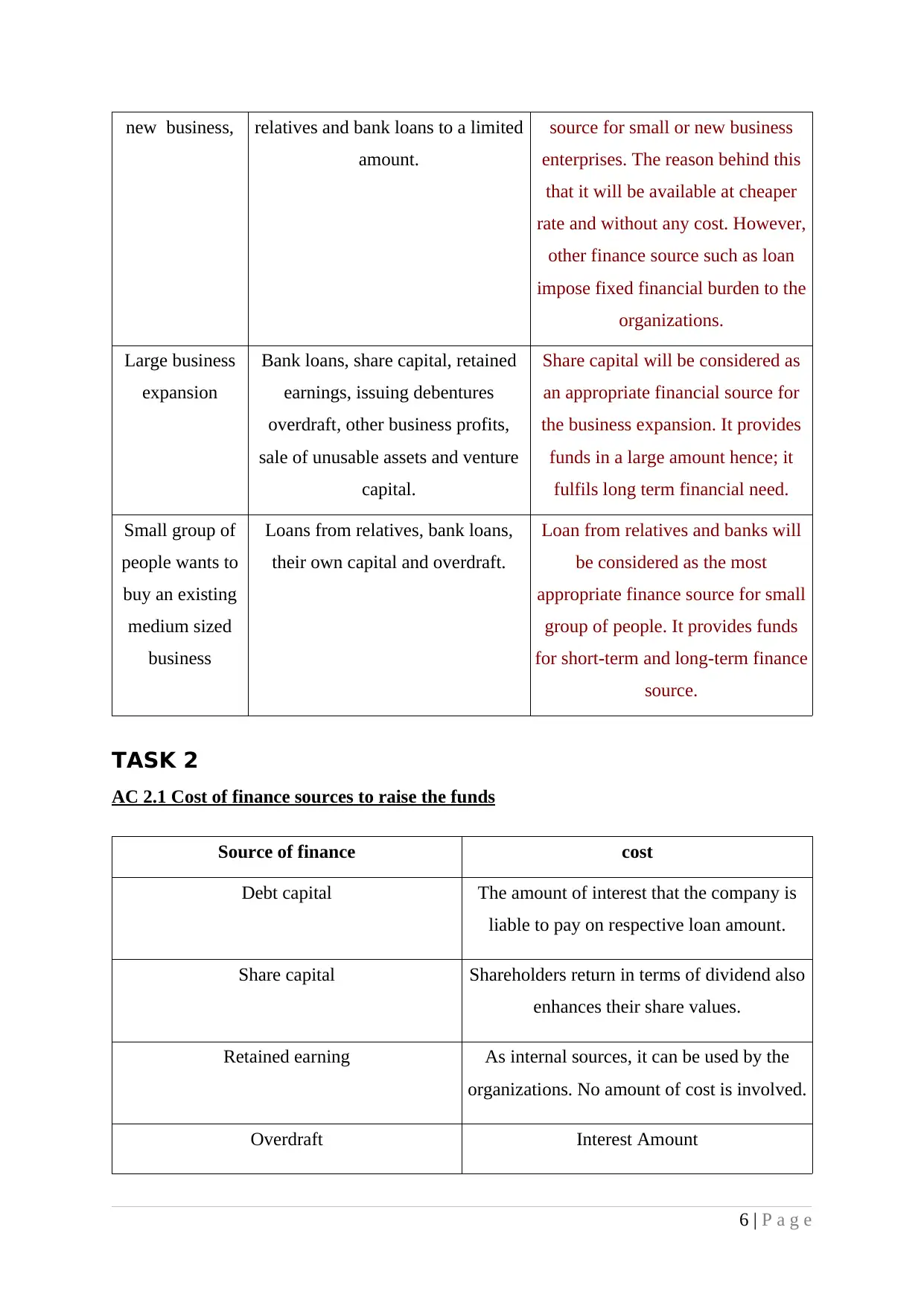
new business, relatives and bank loans to a limited
amount.
source for small or new business
enterprises. The reason behind this
that it will be available at cheaper
rate and without any cost. However,
other finance source such as loan
impose fixed financial burden to the
organizations.
Large business
expansion
Bank loans, share capital, retained
earnings, issuing debentures
overdraft, other business profits,
sale of unusable assets and venture
capital.
Share capital will be considered as
an appropriate financial source for
the business expansion. It provides
funds in a large amount hence; it
fulfils long term financial need.
Small group of
people wants to
buy an existing
medium sized
business
Loans from relatives, bank loans,
their own capital and overdraft.
Loan from relatives and banks will
be considered as the most
appropriate finance source for small
group of people. It provides funds
for short-term and long-term finance
source.
TASK 2
AC 2.1 Cost of finance sources to raise the funds
Source of finance cost
Debt capital The amount of interest that the company is
liable to pay on respective loan amount.
Share capital Shareholders return in terms of dividend also
enhances their share values.
Retained earning As internal sources, it can be used by the
organizations. No amount of cost is involved.
Overdraft Interest Amount
6 | P a g e
amount.
source for small or new business
enterprises. The reason behind this
that it will be available at cheaper
rate and without any cost. However,
other finance source such as loan
impose fixed financial burden to the
organizations.
Large business
expansion
Bank loans, share capital, retained
earnings, issuing debentures
overdraft, other business profits,
sale of unusable assets and venture
capital.
Share capital will be considered as
an appropriate financial source for
the business expansion. It provides
funds in a large amount hence; it
fulfils long term financial need.
Small group of
people wants to
buy an existing
medium sized
business
Loans from relatives, bank loans,
their own capital and overdraft.
Loan from relatives and banks will
be considered as the most
appropriate finance source for small
group of people. It provides funds
for short-term and long-term finance
source.
TASK 2
AC 2.1 Cost of finance sources to raise the funds
Source of finance cost
Debt capital The amount of interest that the company is
liable to pay on respective loan amount.
Share capital Shareholders return in terms of dividend also
enhances their share values.
Retained earning As internal sources, it can be used by the
organizations. No amount of cost is involved.
Overdraft Interest Amount
6 | P a g e
⊘ This is a preview!⊘
Do you want full access?
Subscribe today to unlock all pages.

Trusted by 1+ million students worldwide

Dispose of the assets The efforts that the organization has to make
for sale the assets in the market.
AC 2.2 Importance of financial planning
Financial planning is considered as a special financial instrument that helps in making
effective business decisions for different purposes (Hayre, 2013).
S. No. Importance Description
1 Capital requirement Initially, financial planning considers the amount of
total funds requirement to start and run the business.
2 Debt and capital
composition
It decides the debt equity ratio so as to collect the funds
at minimum the cost that helps in getting larger the
return.
3 Business growth and
success
Financial planning has the objective of maximizing the
profit, wealth and dividend. This in turn, resulted in
achieving the business growth and success.
4 Maximum utilization of
resources
It frames policies in order to ensure optimum
utilization of used finance sources.
5 Cash flow management It evaluates the cash inflows and outflows on a regular
basis that helps in having proper availability of
working capital.
AC 2.3 Types of financial information required for decision making purpose
Every organization need to evaluate and examining its financial information for
decision making purpose. Collecting, processing and analysing the financial data help the
organization in taking strategic decisions. Financial information can be acquired by the
business financial statements. Trading and profit and loss account provide details regarding
business sales, purchase and direct as well as indirect incomes and expenses (Chandra, 2011).
The management can take decisions for reducing the cost and increase the sales by analyse
such statements. This in turn, resulted in increasing the business operational performance.
7 | P a g e
for sale the assets in the market.
AC 2.2 Importance of financial planning
Financial planning is considered as a special financial instrument that helps in making
effective business decisions for different purposes (Hayre, 2013).
S. No. Importance Description
1 Capital requirement Initially, financial planning considers the amount of
total funds requirement to start and run the business.
2 Debt and capital
composition
It decides the debt equity ratio so as to collect the funds
at minimum the cost that helps in getting larger the
return.
3 Business growth and
success
Financial planning has the objective of maximizing the
profit, wealth and dividend. This in turn, resulted in
achieving the business growth and success.
4 Maximum utilization of
resources
It frames policies in order to ensure optimum
utilization of used finance sources.
5 Cash flow management It evaluates the cash inflows and outflows on a regular
basis that helps in having proper availability of
working capital.
AC 2.3 Types of financial information required for decision making purpose
Every organization need to evaluate and examining its financial information for
decision making purpose. Collecting, processing and analysing the financial data help the
organization in taking strategic decisions. Financial information can be acquired by the
business financial statements. Trading and profit and loss account provide details regarding
business sales, purchase and direct as well as indirect incomes and expenses (Chandra, 2011).
The management can take decisions for reducing the cost and increase the sales by analyse
such statements. This in turn, resulted in increasing the business operational performance.
7 | P a g e
Paraphrase This Document
Need a fresh take? Get an instant paraphrase of this document with our AI Paraphraser
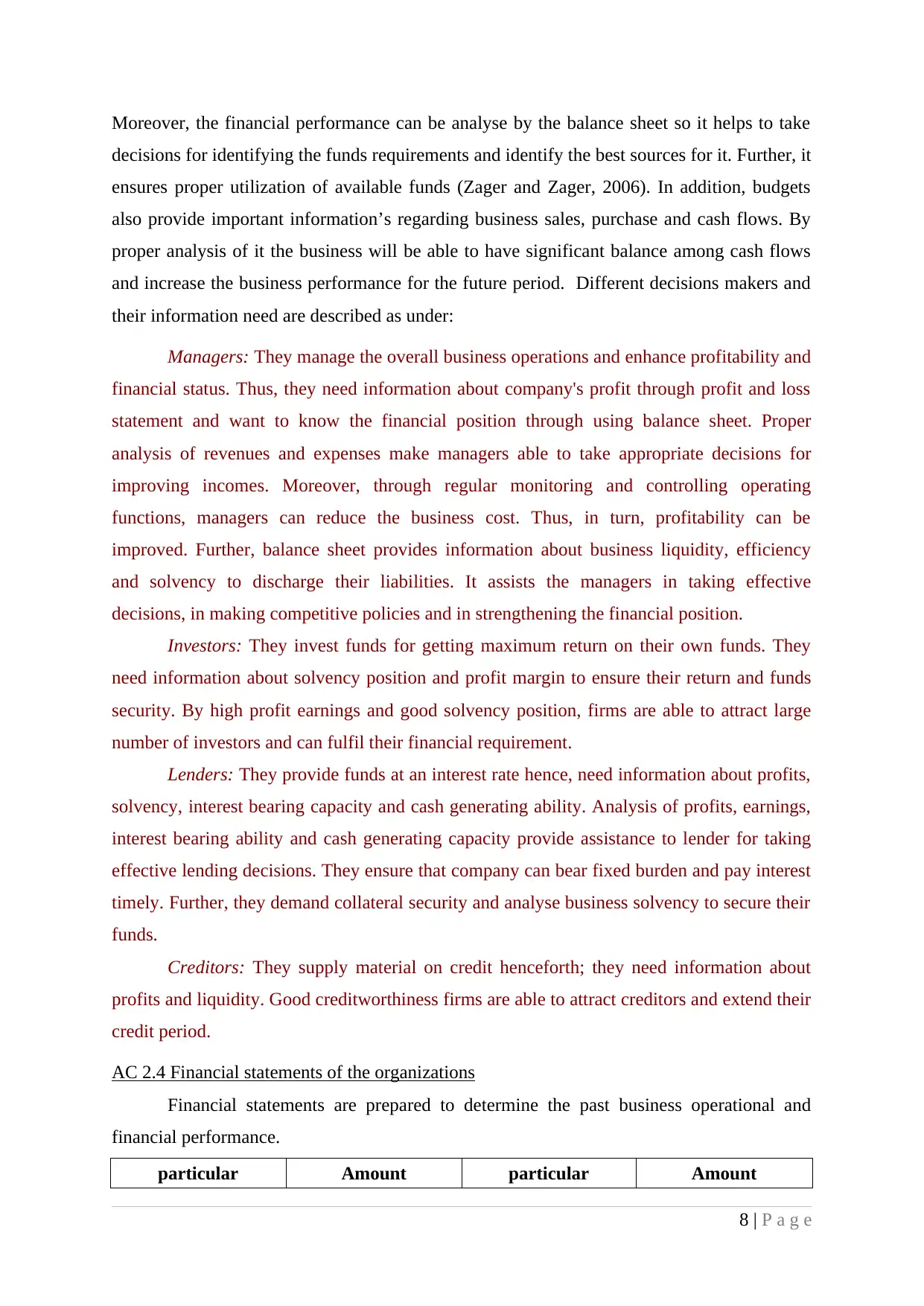
Moreover, the financial performance can be analyse by the balance sheet so it helps to take
decisions for identifying the funds requirements and identify the best sources for it. Further, it
ensures proper utilization of available funds (Zager and Zager, 2006). In addition, budgets
also provide important information’s regarding business sales, purchase and cash flows. By
proper analysis of it the business will be able to have significant balance among cash flows
and increase the business performance for the future period. Different decisions makers and
their information need are described as under:
Managers: They manage the overall business operations and enhance profitability and
financial status. Thus, they need information about company's profit through profit and loss
statement and want to know the financial position through using balance sheet. Proper
analysis of revenues and expenses make managers able to take appropriate decisions for
improving incomes. Moreover, through regular monitoring and controlling operating
functions, managers can reduce the business cost. Thus, in turn, profitability can be
improved. Further, balance sheet provides information about business liquidity, efficiency
and solvency to discharge their liabilities. It assists the managers in taking effective
decisions, in making competitive policies and in strengthening the financial position.
Investors: They invest funds for getting maximum return on their own funds. They
need information about solvency position and profit margin to ensure their return and funds
security. By high profit earnings and good solvency position, firms are able to attract large
number of investors and can fulfil their financial requirement.
Lenders: They provide funds at an interest rate hence, need information about profits,
solvency, interest bearing capacity and cash generating ability. Analysis of profits, earnings,
interest bearing ability and cash generating capacity provide assistance to lender for taking
effective lending decisions. They ensure that company can bear fixed burden and pay interest
timely. Further, they demand collateral security and analyse business solvency to secure their
funds.
Creditors: They supply material on credit henceforth; they need information about
profits and liquidity. Good creditworthiness firms are able to attract creditors and extend their
credit period.
AC 2.4 Financial statements of the organizations
Financial statements are prepared to determine the past business operational and
financial performance.
particular Amount particular Amount
8 | P a g e
decisions for identifying the funds requirements and identify the best sources for it. Further, it
ensures proper utilization of available funds (Zager and Zager, 2006). In addition, budgets
also provide important information’s regarding business sales, purchase and cash flows. By
proper analysis of it the business will be able to have significant balance among cash flows
and increase the business performance for the future period. Different decisions makers and
their information need are described as under:
Managers: They manage the overall business operations and enhance profitability and
financial status. Thus, they need information about company's profit through profit and loss
statement and want to know the financial position through using balance sheet. Proper
analysis of revenues and expenses make managers able to take appropriate decisions for
improving incomes. Moreover, through regular monitoring and controlling operating
functions, managers can reduce the business cost. Thus, in turn, profitability can be
improved. Further, balance sheet provides information about business liquidity, efficiency
and solvency to discharge their liabilities. It assists the managers in taking effective
decisions, in making competitive policies and in strengthening the financial position.
Investors: They invest funds for getting maximum return on their own funds. They
need information about solvency position and profit margin to ensure their return and funds
security. By high profit earnings and good solvency position, firms are able to attract large
number of investors and can fulfil their financial requirement.
Lenders: They provide funds at an interest rate hence, need information about profits,
solvency, interest bearing capacity and cash generating ability. Analysis of profits, earnings,
interest bearing ability and cash generating capacity provide assistance to lender for taking
effective lending decisions. They ensure that company can bear fixed burden and pay interest
timely. Further, they demand collateral security and analyse business solvency to secure their
funds.
Creditors: They supply material on credit henceforth; they need information about
profits and liquidity. Good creditworthiness firms are able to attract creditors and extend their
credit period.
AC 2.4 Financial statements of the organizations
Financial statements are prepared to determine the past business operational and
financial performance.
particular Amount particular Amount
8 | P a g e

To loan interest 2500
To dividend 1200
To interest on
overdraft
150
To interest on
debentures
2000
Liability Amount Assets Amount
6%, Issued Share
Capital
200000
Long term liability
Bank loans @ 10% 250000
10% Debentures 200000
Current liability
Bank Overdrafts 3000
From the above statements, it becomes clear that share capital cost dividend and cost
of loans interest shows in profit and loss account. However, the amount of issued share
capital and taken bank loans will show in liability side. The amount of overdraft shows under
the current liability head and associated interest expenditures shows in profit and loss account
(Davies and Crawford, 2011). On contrary, the amount of debentures shows under the long
term liability and interest amount shows in income statement in debit side.
Owner's fund is the capital contribution hence; it will be shown in capital at the
liability’s side. However, preference share capital will be shown in balance sheet under the
share capital head while its cost dividend will be shown in profit and loss account as
expenditures. Amount used out of retained profits will be shown in reserve and surplus head
of liability’s side. Moreover, it will be included in the statement of retained earnings. On the
contrary, debt interest will be included at the expenditure side of profitability statement.
9 | P a g e
To dividend 1200
To interest on
overdraft
150
To interest on
debentures
2000
Liability Amount Assets Amount
6%, Issued Share
Capital
200000
Long term liability
Bank loans @ 10% 250000
10% Debentures 200000
Current liability
Bank Overdrafts 3000
From the above statements, it becomes clear that share capital cost dividend and cost
of loans interest shows in profit and loss account. However, the amount of issued share
capital and taken bank loans will show in liability side. The amount of overdraft shows under
the current liability head and associated interest expenditures shows in profit and loss account
(Davies and Crawford, 2011). On contrary, the amount of debentures shows under the long
term liability and interest amount shows in income statement in debit side.
Owner's fund is the capital contribution hence; it will be shown in capital at the
liability’s side. However, preference share capital will be shown in balance sheet under the
share capital head while its cost dividend will be shown in profit and loss account as
expenditures. Amount used out of retained profits will be shown in reserve and surplus head
of liability’s side. Moreover, it will be included in the statement of retained earnings. On the
contrary, debt interest will be included at the expenditure side of profitability statement.
9 | P a g e
⊘ This is a preview!⊘
Do you want full access?
Subscribe today to unlock all pages.

Trusted by 1+ million students worldwide
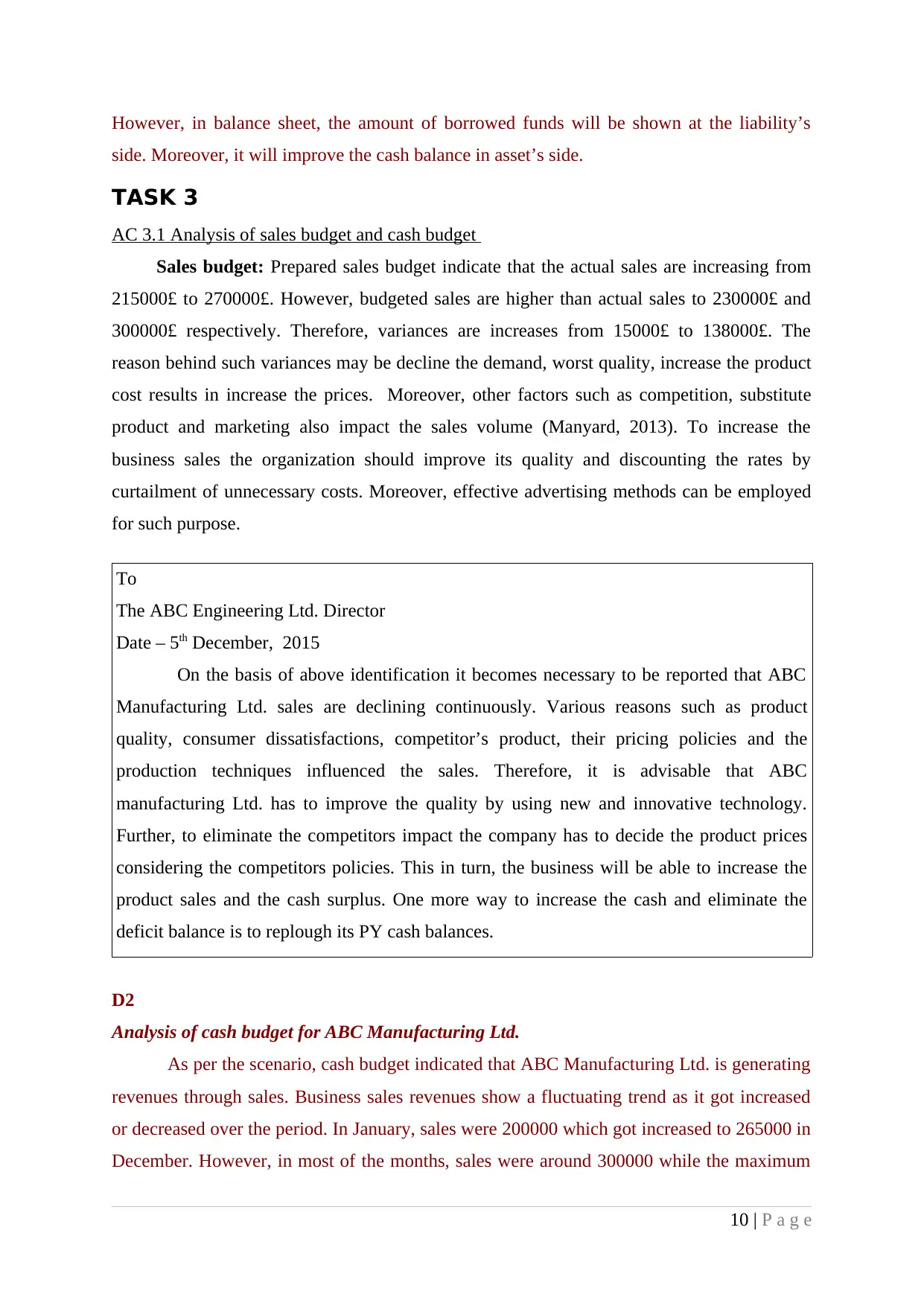
However, in balance sheet, the amount of borrowed funds will be shown at the liability’s
side. Moreover, it will improve the cash balance in asset’s side.
TASK 3
AC 3.1 Analysis of sales budget and cash budget
Sales budget: Prepared sales budget indicate that the actual sales are increasing from
215000£ to 270000£. However, budgeted sales are higher than actual sales to 230000£ and
300000£ respectively. Therefore, variances are increases from 15000£ to 138000£. The
reason behind such variances may be decline the demand, worst quality, increase the product
cost results in increase the prices. Moreover, other factors such as competition, substitute
product and marketing also impact the sales volume (Manyard, 2013). To increase the
business sales the organization should improve its quality and discounting the rates by
curtailment of unnecessary costs. Moreover, effective advertising methods can be employed
for such purpose.
To
The ABC Engineering Ltd. Director
Date – 5th December, 2015
On the basis of above identification it becomes necessary to be reported that ABC
Manufacturing Ltd. sales are declining continuously. Various reasons such as product
quality, consumer dissatisfactions, competitor’s product, their pricing policies and the
production techniques influenced the sales. Therefore, it is advisable that ABC
manufacturing Ltd. has to improve the quality by using new and innovative technology.
Further, to eliminate the competitors impact the company has to decide the product prices
considering the competitors policies. This in turn, the business will be able to increase the
product sales and the cash surplus. One more way to increase the cash and eliminate the
deficit balance is to replough its PY cash balances.
D2
Analysis of cash budget for ABC Manufacturing Ltd.
As per the scenario, cash budget indicated that ABC Manufacturing Ltd. is generating
revenues through sales. Business sales revenues show a fluctuating trend as it got increased
or decreased over the period. In January, sales were 200000 which got increased to 265000 in
December. However, in most of the months, sales were around 300000 while the maximum
10 | P a g e
side. Moreover, it will improve the cash balance in asset’s side.
TASK 3
AC 3.1 Analysis of sales budget and cash budget
Sales budget: Prepared sales budget indicate that the actual sales are increasing from
215000£ to 270000£. However, budgeted sales are higher than actual sales to 230000£ and
300000£ respectively. Therefore, variances are increases from 15000£ to 138000£. The
reason behind such variances may be decline the demand, worst quality, increase the product
cost results in increase the prices. Moreover, other factors such as competition, substitute
product and marketing also impact the sales volume (Manyard, 2013). To increase the
business sales the organization should improve its quality and discounting the rates by
curtailment of unnecessary costs. Moreover, effective advertising methods can be employed
for such purpose.
To
The ABC Engineering Ltd. Director
Date – 5th December, 2015
On the basis of above identification it becomes necessary to be reported that ABC
Manufacturing Ltd. sales are declining continuously. Various reasons such as product
quality, consumer dissatisfactions, competitor’s product, their pricing policies and the
production techniques influenced the sales. Therefore, it is advisable that ABC
manufacturing Ltd. has to improve the quality by using new and innovative technology.
Further, to eliminate the competitors impact the company has to decide the product prices
considering the competitors policies. This in turn, the business will be able to increase the
product sales and the cash surplus. One more way to increase the cash and eliminate the
deficit balance is to replough its PY cash balances.
D2
Analysis of cash budget for ABC Manufacturing Ltd.
As per the scenario, cash budget indicated that ABC Manufacturing Ltd. is generating
revenues through sales. Business sales revenues show a fluctuating trend as it got increased
or decreased over the period. In January, sales were 200000 which got increased to 265000 in
December. However, in most of the months, sales were around 300000 while the maximum
10 | P a g e
Paraphrase This Document
Need a fresh take? Get an instant paraphrase of this document with our AI Paraphraser
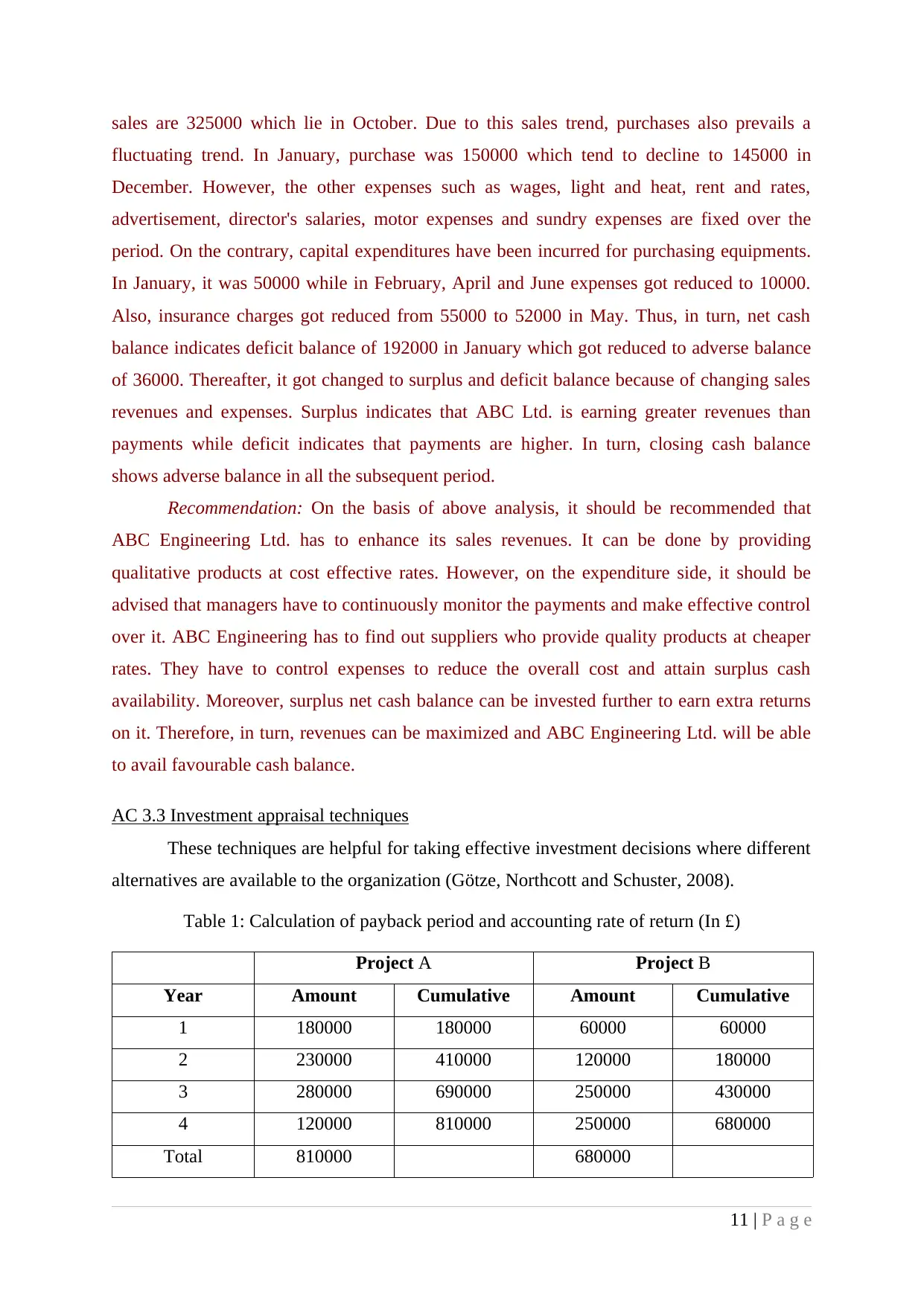
sales are 325000 which lie in October. Due to this sales trend, purchases also prevails a
fluctuating trend. In January, purchase was 150000 which tend to decline to 145000 in
December. However, the other expenses such as wages, light and heat, rent and rates,
advertisement, director's salaries, motor expenses and sundry expenses are fixed over the
period. On the contrary, capital expenditures have been incurred for purchasing equipments.
In January, it was 50000 while in February, April and June expenses got reduced to 10000.
Also, insurance charges got reduced from 55000 to 52000 in May. Thus, in turn, net cash
balance indicates deficit balance of 192000 in January which got reduced to adverse balance
of 36000. Thereafter, it got changed to surplus and deficit balance because of changing sales
revenues and expenses. Surplus indicates that ABC Ltd. is earning greater revenues than
payments while deficit indicates that payments are higher. In turn, closing cash balance
shows adverse balance in all the subsequent period.
Recommendation: On the basis of above analysis, it should be recommended that
ABC Engineering Ltd. has to enhance its sales revenues. It can be done by providing
qualitative products at cost effective rates. However, on the expenditure side, it should be
advised that managers have to continuously monitor the payments and make effective control
over it. ABC Engineering has to find out suppliers who provide quality products at cheaper
rates. They have to control expenses to reduce the overall cost and attain surplus cash
availability. Moreover, surplus net cash balance can be invested further to earn extra returns
on it. Therefore, in turn, revenues can be maximized and ABC Engineering Ltd. will be able
to avail favourable cash balance.
AC 3.3 Investment appraisal techniques
These techniques are helpful for taking effective investment decisions where different
alternatives are available to the organization (Götze, Northcott and Schuster, 2008).
Table 1: Calculation of payback period and accounting rate of return (In £)
Project A Project B
Year Amount Cumulative Amount Cumulative
1 180000 180000 60000 60000
2 230000 410000 120000 180000
3 280000 690000 250000 430000
4 120000 810000 250000 680000
Total 810000 680000
11 | P a g e
fluctuating trend. In January, purchase was 150000 which tend to decline to 145000 in
December. However, the other expenses such as wages, light and heat, rent and rates,
advertisement, director's salaries, motor expenses and sundry expenses are fixed over the
period. On the contrary, capital expenditures have been incurred for purchasing equipments.
In January, it was 50000 while in February, April and June expenses got reduced to 10000.
Also, insurance charges got reduced from 55000 to 52000 in May. Thus, in turn, net cash
balance indicates deficit balance of 192000 in January which got reduced to adverse balance
of 36000. Thereafter, it got changed to surplus and deficit balance because of changing sales
revenues and expenses. Surplus indicates that ABC Ltd. is earning greater revenues than
payments while deficit indicates that payments are higher. In turn, closing cash balance
shows adverse balance in all the subsequent period.
Recommendation: On the basis of above analysis, it should be recommended that
ABC Engineering Ltd. has to enhance its sales revenues. It can be done by providing
qualitative products at cost effective rates. However, on the expenditure side, it should be
advised that managers have to continuously monitor the payments and make effective control
over it. ABC Engineering has to find out suppliers who provide quality products at cheaper
rates. They have to control expenses to reduce the overall cost and attain surplus cash
availability. Moreover, surplus net cash balance can be invested further to earn extra returns
on it. Therefore, in turn, revenues can be maximized and ABC Engineering Ltd. will be able
to avail favourable cash balance.
AC 3.3 Investment appraisal techniques
These techniques are helpful for taking effective investment decisions where different
alternatives are available to the organization (Götze, Northcott and Schuster, 2008).
Table 1: Calculation of payback period and accounting rate of return (In £)
Project A Project B
Year Amount Cumulative Amount Cumulative
1 180000 180000 60000 60000
2 230000 410000 120000 180000
3 280000 690000 250000 430000
4 120000 810000 250000 680000
Total 810000 680000
11 | P a g e
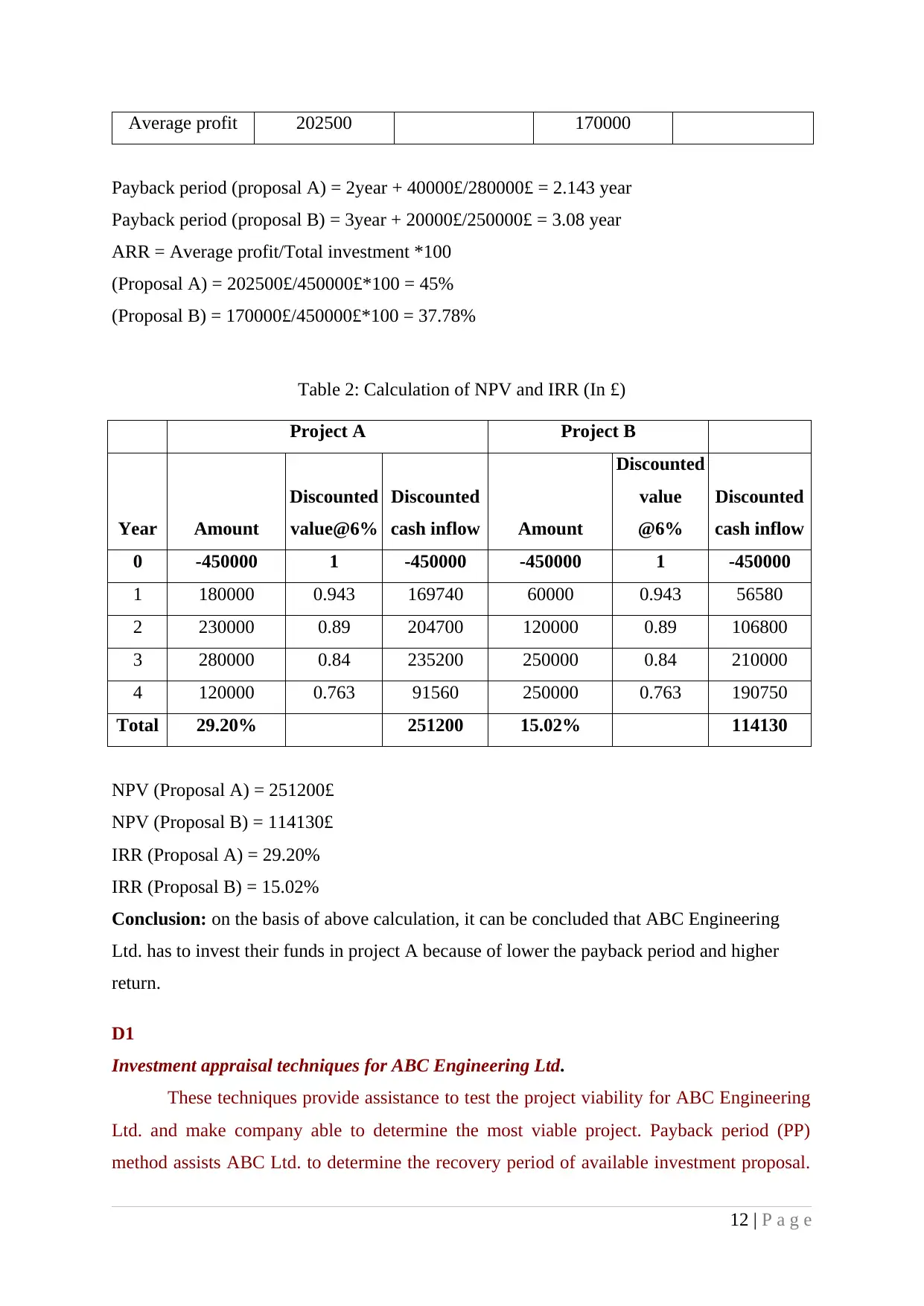
Average profit 202500 170000
Payback period (proposal A) = 2year + 40000£/280000£ = 2.143 year
Payback period (proposal B) = 3year + 20000£/250000£ = 3.08 year
ARR = Average profit/Total investment *100
(Proposal A) = 202500£/450000£*100 = 45%
(Proposal B) = 170000£/450000£*100 = 37.78%
Table 2: Calculation of NPV and IRR (In £)
Project A Project B
Year Amount
Discounted
value@6%
Discounted
cash inflow Amount
Discounted
value
@6%
Discounted
cash inflow
0 -450000 1 -450000 -450000 1 -450000
1 180000 0.943 169740 60000 0.943 56580
2 230000 0.89 204700 120000 0.89 106800
3 280000 0.84 235200 250000 0.84 210000
4 120000 0.763 91560 250000 0.763 190750
Total 29.20% 251200 15.02% 114130
NPV (Proposal A) = 251200£
NPV (Proposal B) = 114130£
IRR (Proposal A) = 29.20%
IRR (Proposal B) = 15.02%
Conclusion: on the basis of above calculation, it can be concluded that ABC Engineering
Ltd. has to invest their funds in project A because of lower the payback period and higher
return.
D1
Investment appraisal techniques for ABC Engineering Ltd.
These techniques provide assistance to test the project viability for ABC Engineering
Ltd. and make company able to determine the most viable project. Payback period (PP)
method assists ABC Ltd. to determine the recovery period of available investment proposal.
12 | P a g e
Payback period (proposal A) = 2year + 40000£/280000£ = 2.143 year
Payback period (proposal B) = 3year + 20000£/250000£ = 3.08 year
ARR = Average profit/Total investment *100
(Proposal A) = 202500£/450000£*100 = 45%
(Proposal B) = 170000£/450000£*100 = 37.78%
Table 2: Calculation of NPV and IRR (In £)
Project A Project B
Year Amount
Discounted
value@6%
Discounted
cash inflow Amount
Discounted
value
@6%
Discounted
cash inflow
0 -450000 1 -450000 -450000 1 -450000
1 180000 0.943 169740 60000 0.943 56580
2 230000 0.89 204700 120000 0.89 106800
3 280000 0.84 235200 250000 0.84 210000
4 120000 0.763 91560 250000 0.763 190750
Total 29.20% 251200 15.02% 114130
NPV (Proposal A) = 251200£
NPV (Proposal B) = 114130£
IRR (Proposal A) = 29.20%
IRR (Proposal B) = 15.02%
Conclusion: on the basis of above calculation, it can be concluded that ABC Engineering
Ltd. has to invest their funds in project A because of lower the payback period and higher
return.
D1
Investment appraisal techniques for ABC Engineering Ltd.
These techniques provide assistance to test the project viability for ABC Engineering
Ltd. and make company able to determine the most viable project. Payback period (PP)
method assists ABC Ltd. to determine the recovery period of available investment proposal.
12 | P a g e
⊘ This is a preview!⊘
Do you want full access?
Subscribe today to unlock all pages.

Trusted by 1+ million students worldwide
1 out of 23
Related Documents
Your All-in-One AI-Powered Toolkit for Academic Success.
+13062052269
info@desklib.com
Available 24*7 on WhatsApp / Email
![[object Object]](/_next/static/media/star-bottom.7253800d.svg)
Unlock your academic potential
Copyright © 2020–2025 A2Z Services. All Rights Reserved. Developed and managed by ZUCOL.





